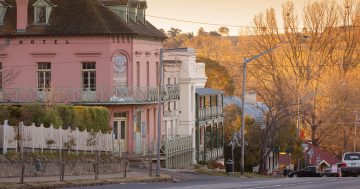
Parliament House, one of the must-see attractions for the increasing number of visitors to the ACT. Photo: VisitCanberra.
The number of overseas and domestic visitors to the ACT continues to grow, with the ACT Government touting the year ending June 2019 as the most successful for tourism on record.
Tourism Research Australia Visitor Survey data released on Wednesday shows 2.90 million Australian overnight visitors, 2.31 million Australian day-trippers, and 266,278 international visitors came to the capital in the year ending June 2019, representing the highest visitor performance on record.
These 5.48 million visitors spent a total of $2.82 billion during their stay, with domestic overnight visitors spending a record $1.87 billion (up 14.8 per cent), domestic day visitors spending $344 million and international overnight visitors spending $605.4 million.
China led the overseas visitor pack, followed by the UK and the US.
Australian overnight visitors were up 5 per cent on the previous year, with visitor nights also up 5 per cent from 7.242 million in 2018 to 7.611 million in 2019.
They spent 14.8 per cent more in the year ending June 2019 compared with 2018, with 7.4 per cent more staying in hotels or other paid accommodation. More nights (3.48 million) were spent in paid accommodation in 2019 than with friends or family (2.986 million), compared to the previous year.
Fewer Australians came to the capital to visit friends or family, with more visiting for holiday or on business.
Despite the introduction of discount carrier Tigerair, 20,000 fewer visitors arrived by air, with a 177,000 increase in the number of people driving to the ACT.
Most overseas visitors were here for a holiday but education ($369 million) contributed to about half of the $605.4 million spent in the year ending June 2019, reflecting the importance of the international education market to the ACT.

Nightfest at Floriade. The annual spring festival is one of Canberra’s big crowd pullers. Photo: Region Media.
This was down on the 2018 figure of $426 million, with 3000 fewer visitors here for education, contributing to a fall overall in the overseas spend from $641 million in the previous period, although visitors here for a holiday or to visit friends or relatives spent more than in 2018, including paid accommodation.
Canberra was ranked eighth in the country by visitor nights in a region, and 10th for backpackers. Around 33,000 backpackers visited in 2019, up from 31,000 in the previous 12 months.
Chief Minister Andrew Barr said the ACT’s tourism and hospitality sector had been one of the biggest drivers behind the Territory’s employment growth, supporting over 16,000 jobs and contributing more than $2 billion to the economy.
“Major events such as Floriade help support local businesses by attracting more visitors to Canberra – filling rooms in our hotels and driving more people to our cafes, restaurants and bars,” he said.
“A record rise in people visiting for holidays and business bumped up the domestic overnight numbers, while record growth in the leisure market of people coming for holidays and to visit family and friends contributed to the international overnight visitor growth.”
Mr Barr said Canberra’s key domestic overnight source markets remained Sydney and regional NSW, followed by Melbourne, regional Victoria and Brisbane.
The top 10 source countries and their share of the ACT international visitor market were:
1. China (20.5 per cent)
2. United Kingdom (8.2 per cent)
3. USA (8.1 per cent)
4. India (7.1 per cent)
5. New Zealand (6.4 per cent)
6. Germany (4.0 per cent)
7. Canada (3.4 per cent)
8. Singapore (3.0 per cent)
9. Taiwan (2.5 per cent)
10. Hong Kong (2.5 per cent).
Mr Barr said the result reflected the ACT Government’s commitment to growing the visitor economy to $2.5 billion by 2020 through concentrated destination marketing efforts across consumer, trade, media engagement, and cooperative campaigns with online travel agents and airlines.
“The success of international tourism in the capital is growing alongside the increase in international flights to Canberra. Between Singapore Airlines and Qatar Airways, 14 international flights per week now arrive at Canberra Airport,” he said.
The ACT Government, along with Canberra Airport, is continuing its push to attract more international carriers to Canberra, particularly from China.





















